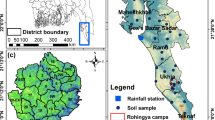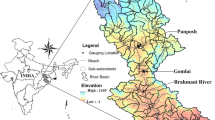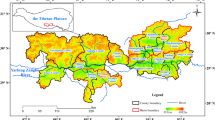Abstract
Floods cause great damage to ecosystems and are among the main agents of soil erosion. Given the importance of soils for the functioning of ecosystems and development and improvement of bio-economic conditions, the risk and rate of soil erosion was assessed using the RUSLE model in Iran’s Lorestan province before and after a period of major floods in late 2018 and early 2019. Furthermore, soil erosion was calculated for current and future conditions based on the Global Soil Erosion Modeling Database (GloSEM). Through the analysis of rainfall events, as the most important agent of soil erosion, the average R-factors for the period before and after flooding were 58.87 and 157.6 MJ mm ha− 1 h− 1 y− 1, respectively. The results showed that agricultural development and land use change are the main causes of land degradation in the southern and central parts of the study area. The impact of floods was also significant since our evaluations showed that soil erosion increased from 4.12 t ha− 1 yr− 1 before the floods to 10.93 t ha− 1 yr− 1 afterwards. Field surveys using 64 ground control points determined that erodibility varies from 0.17 to 0.49% in the study area. Orchards, farms, rangelands, and forests with moderate or low vegetation cover were the most vulnerable land uses to soil erosion. The results of GloSEM modeling revealed that climate change is the main cause of change in the rate of soil erosion. The results also established that when the combined effects of land use change and climate change are taken into account, soil erosion has increased under SSP1-RCP2.6, SSP2-RCP4.5, and SSP5-RCP8.5 scenarios, so that about 80% of the region has experienced moderate to very high erosion. Therefore, both natural factors (e.g. climate change) and human factors (e.g. agricultural development, population growth, and overgrazing) are among the drivers of soil erosion in the study area.





Similar content being viewed by others
References
Adeel Z, Alarcón AM, Bakkensen L, Franco E, Garfin GM et al (2020) Developing a comprehensive methodology for evaluating economic impacts of floods in Canada, Mexico and the United States. Int J Disaster Risk Reduct 50:101861. https://doi.org/10.1016/j.ijdrr.2020.101861
Adikari Y, Yoshitani J (2009) Global Trends in Water-Related Disasters: an insight for policymakers—the United Nations World Water Assessment Programme; the United Nations Educational. Paris, France, Scientific and Cultural Organization
Aiello A, Adamo M, Canora F (2015) Remote sensing and GIS to assess soil erosion with RUSLE3D and USPED at river basin scale in southern Italy. CATENA 131:174–185. https://doi.org/10.1016/j.catena.2015.04.003
Akbari M, Ownegh M, Asgari H, Sadoddin A, Khosravi H (2016a) Desertification Risk Assessment and Management Program. Glob J Environ Sci Manag 2(4):365–380. https://doi.org/10.22034/gjesm.2016.02.04.006
Akbari M, Ownegh M, Asgari H, Sadoddin A, Khosravi H (2016) Soil erosion risk assessment using the CORINE Model (case study: semi-arid region in Golestan Province). J Desert Eco Eng 12:63–78
Akbari M, Ranaee E, Mirzakhan H, Dargahi A, Jargeh M (2017) Simulation of Snowmelt Runoff using SRM model and comparison with neural networks ANN and ANFIS (Case Study; Kardeh dam basin). J Water Soil 30(6):1794–1807
Akbari M, Neamatollahi E, Neamatollahi P (2019) Evaluating land suitability for spatial planning in arid regions of eastern Iran using fuzzy logic and multi-criteria analysis. Ecol Indic 98:587–598. https://doi.org/10.1016/j.ecolind.2018.11.035
Akbari M, Neamatollahi E, Alizadeh Noughani M, Memarian H (2022) Spatial distribution of soil erosion risk and its economic impacts using an integrated CORINE-GIS approach. Environ Earth Sci 81(10):1–17. https://doi.org/10.1007/s12665-022-10405-w
Alkharabsheh MM, Alexandridis TK, Bilas G, Misopolinos N, Silleos N (2013) Impact of land cover change on soil erosion hazard in northern Jordan using remote sensing and GIS. Procedia Environ Sci 19:912–921
Arnoldus HMJ (1980) An approximation of the rainfall factor in the universal soil loss equation. In: De Boodt M, Gabriels D (eds) Assessment of erosion.Wiley, Chichester, pp 127–132 at a regional scale using GIS. Ekológia (Bratislava). 21: 404–422
Arnell NW, Gosling SN (2016) The impacts of climate change on river flood risk at the global scale. Clim Chang 134:387–401. https://doi.org/10.1007/s10584-014-1084-5
Bhandari KP, Aryal J, Darnsawasdi R (2015) A geospatial approach to assessing soil erosion in a watershed by integrating socio-economic determinants and the RUSLE model. Nat Hazards 75(1):321–342
Boardman J, Poesen J (2006) Soil Erosion in Europe, Wiley
Borrelli P, Robinson DA, Panagos P, Lugato E, Yang JE, Alewell et al (2020) Land use and climate change impacts on global soil erosion by water (2015–2070). Proc Nat Acad Sci 117(36):21994–22001
Bosco C, De Rigo D, Dewitte O, Poesen J, Panagos P (2015) Modeling soil erosion at european scale: towards harmonization and reproducibility. Nat Hazards Earth Syst Sci 15:225–245. https://doi.org/10.5194/nhess-15-225-2015
Brevik EC, Slaughter L, Singh BR, Steffan JJ, Collier D, Barnhart P, Pereira P (2020) Soil and human health: current status and future needs show less. Air Soil Water Res 13:1–23. https://doi.org/10.1177/1178622120934441
Chakrabortty R, Pal SC, Chowdhuri I et al (2020a) Assessing the importance of static and dynamic causative factors on Erosion Potentiality using SWAT, EBF with uncertainty and plausibility, logistic regression and Novel Ensemble Model in a sub-tropical environment. J Indian Soc Remote Sens 48:765–789. https://doi.org/10.1007/s12524-020-01110-x
Chakrabortty R, Pal SC, Sahana M et al (2020b) Soil erosion potential hotspot zone identification using machine learning and statistical approaches in eastern India. Nat Hazards 104:1259–1294. https://doi.org/10.1007/s11069-020-04213-3
Chakrabortty R, Pradhan B, Mondal P, Pal SC (2020c) The use of RUSLE and GCMs to predict potential soil erosion associated with climate change in a monsoon-dominated region of eastern India. Arab J Geosci 13(20):1–20
Chandra Pal S, Shit M (2017) Application of RUSLE model for soil loss estimation of Jaipanda watershed, West Bengal. Spat. Inf. Res. 25:399–409. https://doi.org/10.1007/s41324-017-0107-5
Chandra Pal S, Chakraborttt R, Roy P, Chowdhuri I, Das B, Saha A, Shit M (2021) Changing climate and land use of 21st century influences soil erosion in India. Gondwana Res 94:164–185. https://doi.org/10.1016/j.gr.2021.02.021
Chinnasamy P, Honap VU, Maske AB (2020) Impact of 2018 Kerala floods on soil erosion: need for post-disaster soil management. J Indian Soc Remote Sens 48(10):1373–1388
Cramer W, Yohe GW, Auffhammer M, Huggel C, Molau U, Da Silva Dias MAF, Solow A, Stone DA, Tibig L, Leemans R et al (2014) Detection and attribution of observed impacts. Clim. Chang. 2014 Impacts Adapt. Vulnerability Part A Glob. Sect. Asp. 979–1038. Available online: https://www.zora.uzh.ch/id/eprint/105700/1/2014_HuggelC_WGIIAR5-Chap18_FINAL%20.pdf . Accessed on 16 June 2020
Cox C, Jin L, Ganjegunte G, Borrok D, Lougheed V, Ma L (2018) Soil quality changes due to flood irrigation in agricultural fields along the Rio Grande in western Texas. Appl Geochem 90:87–100
Das B, Paul A, Bordoloi R, Tripathi OP, Pandey PK (2018) Soil erosion risk assessment of hilly terrain through integrated approach of RUSLE and geospatial technology: a case study of Tirap District, Arunachal Pradesh. Model Earth Syst Environ 4(1):373–381
Derakhshan-Babaei F, Nosrati K, Ahmadi Mirghaed F, Egli M (2021) The interrelation between landform, land-use, erosion and soil quality in the Kan catchment of the Tehran province, central Iran. CATENA 204:105412. https://doi.org/10.1016/j.catena.2021.105412
Desmet PJ, Govers G (1996) A GIS procedure for automatically calculating the USLE LS factor on topographically complex landscape units. J Soil and Water Conserv 51:427–433
El Garouani A, Chen H, Lewis L, Tribak A, Ab-harour M (2008) Cartographie de l’utilisation du sol et de l’érosion nette a partir d’images satellitaires et du SIG idrisi au nord-est du Maroc. Ed Sci GB 8(3):193–201
El Jazouli A, Barakat A, Ghafiri A, El Moutaki S, Ettaqy A (2017) Soil erosion modeled with USLE, GIS, and remote sensing: a case study of Ikkour watershed in Middle Atlas (Morocco). Geosci Lett 4:25. https://doi.org/10.1186/s40562-017-0091-6
FAO (2015) Healthy soils are the basis for healthy food production (Food and Agriculture Organization of the United Nations [FAO], 2015), pp. 1–4. http://www.fao.org/documents/card/en/c/645883 cd-4b16-a7b8-34babbb3c505/ba28. Accessed 11 August 2020
Foley JA et al (2011) Solutions for a cultivated planet. Nature 478:337–342
Haregeweyn N, Tsunekawa A, Poesen J, Tsubo M, Meshesha DT, Fenta AA, Nyssen J, Adgo E (2017) Comprehensive assessment of soil erosion risk for better land use planning in river basins: Case study of the Upper Blue Nile River. Sci Total Environ 574:95–108
Hydrological R (2019) Regional water company of Lorestan Province, p 125
Iranian Ministry of Agriculture (2020) Statistics of changes in land cultivation in Lorestan province, p 132
Jiang L, Yao Z, Liu Z, Wu S, Wang R, Wang L (2015) Estimation of soil erosion in some sections of Lower Jinsha River based on RUSLE. Nat Hazards 76(3):1831–1847
Kakembo V, Rowntree KM (2003) The relationship between land use and soil erosion in the communal lands near Peddie Town, Eastern Cape, South Africa. Land Degrad Dev 14(1):39–49
Khademalrasoul A, Amerikhah H (2021) Assessment of soil erosion patterns using RUSLE model and GIS tools (case study: the border of Khuzestan and Chaharmahal Province, Iran). Model Earth Syst Environ 7(2):885–895
Kouli M, Soupios P, Vallianatos F (2009) Soil erosion prediction using the revised universal soil loss equation (RUSLE) in a GIS framework, Chania, Northwestern Crete, Greece. Environ Geol 57(3):483–497
Krishna Bahadur KC (2009) Mapping soil erosion susceptibility using remote sensing and GIS: a case of the Upper Nam Wa Watershed, Nan Province. Thail Environ Geol 57:695–705
Lal R (2008) Land degradation and pedological processes in a changing climate. Carbon Management and Sequestration Center, the Ohio State University, Columbus, OH, p 43210
Lin CY, Lin WT, Chou WC (2002) Soil erosion prediction and sediment yield estimation: the Taiwan experience. Soil Tillage Res 68:143–152
Liu L, Zhang X, Gao Y, Chen X, Shuai X, Mi J (2021) Finer-resolution mapping of Global Land Cover: recent developments, consistency analysis, and prospects. J Remote Sens 38:5289697. https://doi.org/10.34133/2021/5289697
Masroor M, Sajjad H, Rehman S, Singh R, Rahaman MH, Sahana M, Avtar R (2022) Analysing the relationship between drought and soil erosion using vegetation health index and RUSLE models in Godavari middle sub-basin, India. Geosci Front 13(2):101312
Merz B, Kreibich H, Schwarze R, Thieken A (2010) Assessment of economic flood damage. Nat Hazards Earth Syst Sci 10:1697–1724
Memarian H, Akbari M (2021) Prediction of combined effect of climate and land use changes on soil erosion in Iran using GloSEM data. Iran J Ecohydrol 8(2):513–534. https://doi.org/10.22059/ije.2021.320754.1482
Meshesha DT, Tsunekawa A, Tsubo M, Haregeweyn N (2012) Dynamics and hotspots of soil erosion and management scenarios of the Central Rift Valley of Ethiopia. Int J Sediment Res 27(1):84–99
Montanarella L (2015) Agricultural policy: govern our soils. Nature 528:32–33
Moore ID, Burch GJ (1986) Physical basis of the length slope factor in the Universal Soil loss equation. Soil Sci Soc Am J 50(5):1294–1298
Morgan RPC (2005) Soil erosion and conservation. Wiley
Mueller ND et al (2013) Corrigendum: closing yield gaps through nutrient and water management. Nature 494:390
Nabati J, Nezami A, Neamatollahi E, Akbari M (2020) GIS-based agro-ecological zoning for crop suitability using fuzzy inference system in semi-arid regions. Ecol Indic 117:106646. https://doi.org/10.1016/j.ecolind.2020.106646
Nachtergaele FO (2004) Land degradation assessment indicators and the LADA project, land and water development division. FAO, Italy
Neamatollahi E, Vafabakhshi J, Jahansuz MR, Sharifzadeh F (2017) Agricultural optimal cropping pattern determination based on fuzzy system. Fuzzy Inf Eng 9:479–491. https://doi.org/10.1016/j.fiae.2017.12.004
Nepal S, Tripathi S, Adhikari H (2021) Geospatial approach to the risk assessment of climate-induced disasters (drought and erosion) and impacts on out-migration in Nepal. Int J Disaster Risk Reduct 59:102241. https://doi.org/10.1016/j.ijdrr.2021.102241
Nga PH, Takara K, Van NC (2018) Integrated approach to analyze the total flood risk for agriculture: the significance of intangible damages—a case study in Central Vietnam. Int J Disaster Risk Reduct 31:862–872
O’Neal MR, Nearing MA, Vining RC, Southworth J, Pfeifer RA (2005) Climate change impacts on soil erosion in Midwest United States with changes in crop management. CATENA 61:165–184
Pal SC, Chakrabortty R (2019a) Simulating the impact of climate change on soil erosion in sub-tropical monsoon dominated watershed based on RUSLE, SCS runoff and MIROC5 climatic model. Adv Space Res 64(2):352–377
Pal SC, Chakrabortty R (2019b) Modeling of water induced surface soil erosion and the potential risk zone prediction in a sub-tropical watershed of Eastern India. Model Earth Syst Environ 5(2):369–393. https://doi.org/10.1007/s40808-018-0540-z
Pal SC, Shit M (2017) Application of RUSLE model for soil loss estimation of Jaipanda watershed, West Bengal. Spat Inf Res 25(3):399–409
Panagos P, Meusburger K, Marc VL, Alewell C, Hiederer R, Montanarella L (2014) Assessing soil erosionin Europe based on data collected through a european network. Soil Sci Plant Nutr 60:15–29. https://doi.org/10.1080/00380768.2013.835701
Polykretis C, Alexakis DD, Grillakis MG, Manoudakis S (2020) Assessment of intra-annual and inter-annual variabilities of soil erosion in Crete Island (Greece) by incorporating the dynamic “Nature” of R and C-Factors in RUSLE modeling. Remote Sens 12(15):2439
Prasannakumar V, Shiny R, Geetha N, Vijith HJ (2011) Spatial prediction of soil erosion risk by remote sensing, GIS and RUSLE approach: a case study of Siruvani river watershed in Attapady valley, Kerala, India. Environ Earth Sci 64(4):965–972
Quinton JN, Govers G, Van Oost K, Bardgett RD (2010) The impact of agricultural soil erosion on biogeochemical cycling. Nat Geosci 3:311–314. https://doi.org/10.1038/ngeo838
Renard K, Foster G, Weesies G, McCool D, Yoder D (1997) Predicting soil erosion by water: a guide to conservation planning with the Revised Universal Soil Loss Equation (RUSLE). Agricultural Handbook. 703, 65–100
Sadeghi SH, Gholami L, Khaledi Darvishan A, Saeidi P (2014) A review of the application of the MUSLE model worldwide. Hydrol Sci J 59(2):365–375. https://doi.org/10.1080/02626667.2013.866239
Salvati L, Smiraglia D, Bajocco S, Ceccarelli T, Zitti M, Perini L (2013) Map of long-term changes in land sensitivity to degradation of Italy. J Maps 10:65–72. https://doi.org/10.1080/17445647.2013.842506
Samanta S, Koloa C, Pal DK, Palsamanta B (2016) Estimation of potential soil erosion rate using RUSLE and E30 model. Model Earth Syst Environ 2(3):1–11
Sarbazi M, Ownegh M, Behbahani AM, Akbari M (2021) Evaluating and modeling temporal-spatial changes of Land Use in the expansion of Desertification Intensity in the arid regions of Northeast Iran (Sarakhs). Geogr Environ Hazards 9(2):1–18. https://doi.org/10.22067/geo.v9i2.85890
Sharafi S, Noorollahi D, in National Lands Using Spatial Planning Approach (2020) Assessing the Agricultural Land Use Potential : The Case Study of Chalancholan Basin, East of Lorestan Province. Town and country planning. 12(2): 331–357. https://doi.org/10.22059/jtcp.2020.304873.670128
Sholihah Q, Kuncoro W, Wahyuni S, Suwandi SP, Feditasari ED (2020) The analysis of the causes of flood disasters and their impacts in the perspective of environmental law. In IOP conference series: Earth Environ Sci. 437(1): 012056
Silva RM, Montenegro SM, Santos CA (2012) Integration of GIS and remote sensing for estimation of soil loss and prioritization of critical sub-catchments-a case study of Tapacura catchment. Nat Hazards 62:953–970. https://doi.org/10.1007/s11069-012-0128-2
Soil T (1975) A Basic System of Soil Classification for Making and Interpreting Soil Surveys, USDA-SCS Agriculture Handbook, No. 436. (US Government Print. Office, Washington, DC, 1975)
Telles TS, Guimarães M, Dechen SC (2011) The costs of soil erosion. Rev Bras Cienc Solo 35:287–298
Tsara M, Kosmas C, Kirkby MJ, Kosma D, Yassoglou N (2006) An evaluation of the PESERA soil erosion model and its application to a case study in Zakynthos, Greece. Soil Use Manag 21:377–385. https://doi.org/10.1079/SUM2005322
UNDRR (2020) Annual report capturing output and impact for 2020. United Nations Office for Disaster Risk Reduction. https://www.undrr.org/publication/undrr-annual-report-2020 . Accessed on 09 June 2020
Wischmeier WH, Smith DD (1978) Predicting rainfall erosion losses. Agric Handb Not 537(537):285–291. https://doi.org/10.1029/TR039i002p00285
Yao X, Yu J, Jiang H, Sun W, Li Z (2016) Roles of soil erodibility, rainfall erosivity and land use in affecting soil erosion at the basin scale. Agric Water Manag 174:82–92
Zhang Q, Gu X, Singh VP, Liu L, Kong D (2016) Flood-induced agricultural loss across China and impacts from climate indices. Glob Planet Change 139:31–43
Funding
This study was supported by the Faculty of Natural Resources and Environment at Ferdowsi University of Mashhad under Grant No. 50654. Therefore, we thank all those who have helped us in the process. The authors are grateful to the anonymous reviewers for their insightful and helpful comments to improve the manuscript.
Author information
Authors and Affiliations
Corresponding author
Ethics declarations
Conflict of interest
The authors declare that they have no known competing financial interests or personal relationships that could have appeared to influence the work reported in this paper.
Consent for publication
Analysis of the spatial distribution of soil erosion showed that the southern parts (such as Poldakhtar) and central and eastern parts (such as Khorramabad and Aligudarz) have experienced significant erosion after floods.
Additional information
Publisher’s Note
Springer Nature remains neutral with regard to jurisdictional claims in published maps and institutional affiliations.
Rights and permissions
Springer Nature or its licensor (e.g. a society or other partner) holds exclusive rights to this article under a publishing agreement with the author(s) or other rightsholder(s); author self-archiving of the accepted manuscript version of this article is solely governed by the terms of such publishing agreement and applicable law.
About this article
Cite this article
Akbari, M., Neamatollahi, E., Memarian, H. et al. Assessing impacts of floods disaster on soil erosion risk based on the RUSLE-GloSEM approach in western Iran. Nat Hazards 117, 1689–1710 (2023). https://doi.org/10.1007/s11069-023-05925-y
Received:
Accepted:
Published:
Issue Date:
DOI: https://doi.org/10.1007/s11069-023-05925-y




